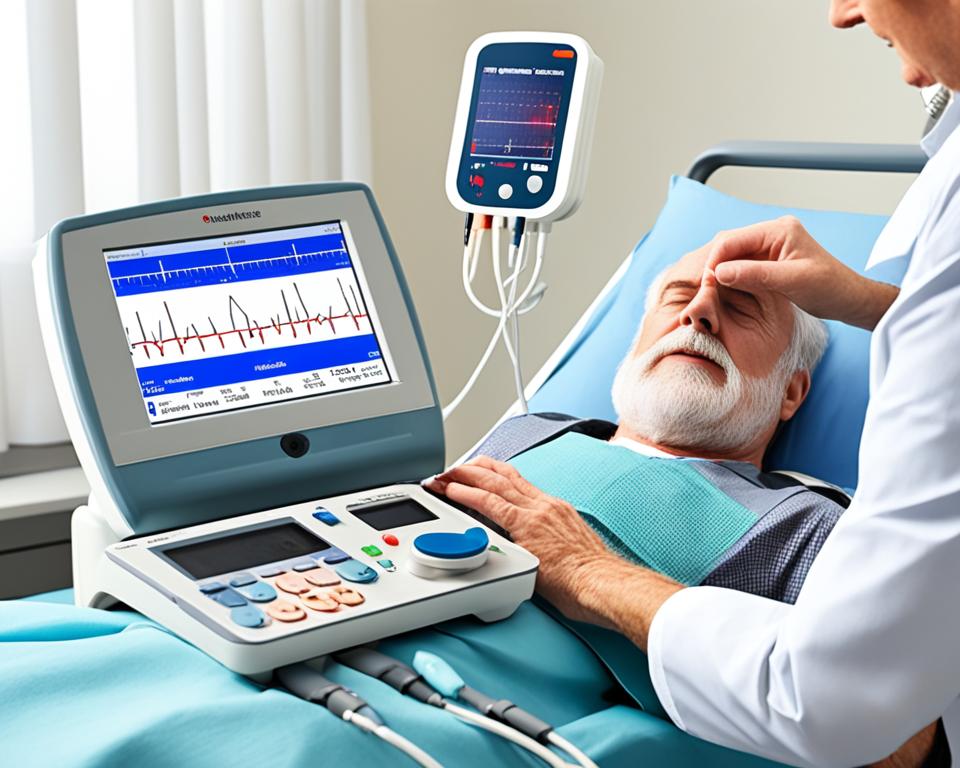Welcome to our comprehensive guide on the therapeutic uses of quinidine. Quinidine is a medication commonly prescribed for heart rhythm disorders and has a wide range of applications. In this article, we will delve into the benefits and applications of quinidine, providing you with valuable insights and information.
Key Takeaways:
- Quinidine is a versatile medication used for the treatment of various heart rhythm disorders.
- It helps restore and maintain a normal heart rhythm over time.
- Quinidine is effective in controlling atrial fibrillation, a specific type of arrhythmia.
- It is also utilized in the treatment of ventricular arrhythmia and other cardiac conditions.
- Quinidine is a derivative of quinine and is an effective treatment option for malaria.
Treatment of Arrhythmias

Arrhythmias are characterized by irregular heart rhythms, which can be concerning for individuals experiencing them. Fortunately, quinidine offers a viable treatment option for managing these irregularities and restoring a normal heart rhythm.
Quinidine acts by regulating the electrical signals within the heart, helping to maintain a steady and consistent heartbeat. By inhibiting certain ion channels responsible for irregular heart rhythms, quinidine effectively controls arrhythmias and prevents their recurrence.
One of the key benefits of using quinidine for arrhythmia treatment is its ability to restore a regular heart rhythm and maintain it over time. This helps reduce symptoms associated with arrhythmias, such as palpitations, shortness of breath, and fatigue, improving the overall quality of life for patients.
Furthermore, quinidine can be particularly useful in cases where other treatment options have failed or are not suitable. It offers a reliable alternative for individuals who may not be candidates for procedures like catheter ablation or those who prefer a non-invasive approach.
Quinidine is a valuable medication for treating arrhythmias, as it directly targets the irregular heart rhythms and helps restore normalcy. Its effectiveness in controlling and managing arrhythmias makes it an essential tool in the management of cardiac rhythm disorders.
When prescribing quinidine for arrhythmias, healthcare professionals consider various factors, including the specific type of arrhythmia, its severity, and the patient’s overall health. The dosage and frequency of administration may vary depending on individual needs and response to treatment.
Possible side effects associated with quinidine treatment for arrhythmias:
- Persistent nausea or vomiting
- Diarrhea
- Dizziness
- Headache
- Visual disturbances
If any of these side effects occur or persist, it is crucial to seek medical attention promptly. Additionally, regular monitoring and follow-up appointments with a healthcare professional are essential to ensure the medication’s optimal effectiveness and minimize potential risks.
Quinidine’s effectiveness as a treatment for arrhythmias has made it a valuable tool in managing and controlling irregular heart rhythms. Whether used as a primary treatment option or in combination with other interventions, quinidine provides individuals with a pathway to a more stable and regular heart rhythm.
Atrial Fibrillation Control

Atrial fibrillation is a specific type of arrhythmia characterized by irregular heartbeats in the upper chambers of the heart, known as the atria. This condition can significantly impact a person’s quality of life and increase the risk of complications such as stroke. Effective management of atrial fibrillation is crucial to reduce symptoms and improve overall cardiac health.
Quinidine has emerged as a valuable tool in controlling atrial fibrillation and restoring a regular heart rhythm. As a class I antiarrhythmic medication, quinidine works by regulating the electrical activity in the heart, allowing for a more stable heartbeat.
“Quinidine has demonstrated significant efficacy in the control of atrial fibrillation, helping patients achieve a more stable heart rhythm and a better quality of life.”
With the appropriate dosage and under medical supervision, quinidine can be a crucial component of a comprehensive treatment plan for atrial fibrillation. The medication effectively reduces the frequency and duration of atrial fibrillation episodes, minimizing symptoms such as palpitations, shortness of breath, and fatigue.
Aside from providing symptom relief, quinidine can also help manage the long-term consequences of atrial fibrillation. By maintaining a stable heart rhythm, quinidine contributes to the prevention of blood clots that can lead to stroke.
In combination with lifestyle changes and other interventions, quinidine plays a significant role in managing atrial fibrillation and enhancing the overall well-being of individuals with this condition.
Benefits of Quinidine for Atrial Fibrillation:
- Restores a regular heart rhythm
- Reduces the frequency and duration of atrial fibrillation episodes
- Alleviates symptoms such as palpitations, shortness of breath, and fatigue
- Minimizes the risk of blood clot formation and stroke
- Improves overall quality of life
While quinidine can be highly effective in managing atrial fibrillation, it is essential to consult with a healthcare professional to determine if it is the right treatment option for each individual. This will ensure proper evaluation, dosage adjustments, and monitoring to achieve optimal results and minimize potential side effects.
| Key Points: |
|---|
| Quinidine is effective in controlling atrial fibrillation |
| It restores a regular heart rhythm and reduces symptoms |
| Quinidine helps minimize the risk of complications such as stroke |
| Consultation with a healthcare professional is essential for personalized treatment |
Ventricular Arrhythmia Treatment

Ventricular arrhythmia is a condition that causes irregular heartbeats originating from the ventricles, which are the lower chambers of the heart. Managing ventricular arrhythmia is crucial to ensure proper heart function and prevent potential complications. Quinidine has emerged as an effective treatment option for individuals with ventricular arrhythmia.
Quinidine works by regulating and stabilizing the electrical activity in the heart, helping to restore a normal heart rhythm. By blocking specific channels responsible for irregular heartbeats, it can effectively manage ventricular arrhythmia and improve the overall cardiac function.
When prescribed for ventricular arrhythmia, quinidine is typically used in combination with other medications or therapies, depending on the severity and underlying causes of the condition. It is essential to consult with a healthcare professional to determine the most suitable treatment plan.
Benefits of Quinidine for Ventricular Arrhythmia
- Restores normal heart rhythm: Quinidine helps regulate the electrical signals in the heart, restoring a normal heart rhythm.
- Reduces symptoms: By managing ventricular arrhythmia, quinidine can alleviate symptoms such as palpitations, dizziness, and shortness of breath.
- Improves overall cardiac function: Proper management of ventricular arrhythmia with quinidine promotes better heart function, reducing the risk of complications.
It is important to note that quinidine may not be suitable for everyone with ventricular arrhythmia. Your healthcare provider will consider various factors, such as your medical history, overall health, and potential drug interactions, before prescribing quinidine.
| Advantages | Considerations |
|---|---|
| Effectively controls ventricular arrhythmia | Status report required for monitoring |
| Relieves symptoms associated with irregular heartbeats | Potential side effects |
| Promotes better heart function | Requires individualized dosage adjustments |
As with any medication, quinidine may cause side effects, ranging from mild to severe. Common side effects include nausea, diarrhea, dizziness, and headache. It is important to report any concerning or persistent side effects to your healthcare provider.
Overall, quinidine holds promise in the treatment of ventricular arrhythmia, offering effective control of irregular heartbeats and improvement in cardiac function. However, it is crucial to work closely with your healthcare provider to determine the most appropriate treatment approach and ensure proper management of this condition.
Other Cardiac Conditions
Quinidine not only plays a significant role in treating arrhythmias but also shows potential benefits in managing other cardiac conditions, such as cardiomyopathy. Cardiomyopathy refers to a group of diseases that affect the heart muscle, leading to abnormal heart function. Quinidine, with its ability to regulate heart rhythms, has shown promise in improving the symptoms and overall quality of life for individuals with cardiomyopathy.
Benefits of Quinidine for Cardiomyopathy
Research suggests that quinidine may help stabilize heart rhythms and reduce the risk of life-threatening arrhythmias in individuals with cardiomyopathy. By addressing the underlying electrical abnormalities in the heart, quinidine can help restore normal heart function and improve cardiac performance.
“Quinidine has been a game-changer for my patients with cardiomyopathy. It has significantly reduced their arrhythmia burden and improved their overall cardiac function, enabling them to lead healthier, more active lives.”
In addition, quinidine has shown promise in enhancing the efficiency of heart muscle contractions, which can lead to improved cardiac output and better exercise tolerance. This medication may also help manage symptoms such as shortness of breath, chest pain, and fatigue, allowing individuals with cardiomyopathy to better manage their condition and enjoy a higher quality of life.
Consult a Healthcare Professional
It is important to note that the use of quinidine for cardiomyopathy should always be determined and monitored by a healthcare professional. They will consider factors such as the specific type of cardiomyopathy, the individual’s overall health, and any potential interactions with other medications. Proper medical supervision ensures the safe and effective use of quinidine for managing cardiomyopathy.
Summary
In summary, quinidine offers potential benefits beyond treating arrhythmias and shows promise in managing other cardiac conditions, including cardiomyopathy. While additional research is still required, the positive impact of quinidine on stabilizing heart rhythms and improving cardiac function makes it a valuable option for individuals with cardiomyopathy. Consultation with a healthcare professional is essential for determining the appropriate use of quinidine and ensuring optimal management of cardiac conditions.
Malaria Treatment
Malaria Treatment

In the fight against malaria, quinidine, a derivative of quinine, emerges as a powerful treatment option. With its potent antimalarial properties, quinidine plays a vital role in combating malaria infections and saving lives. Let’s explore how quinidine is used, its mechanism of action, and its contribution to global malaria control efforts.
Effective Combatant Against Malaria Infection
Quinidine serves as an essential weapon in the battle against malaria. As a quinine derivative, it exhibits antimalarial activity by suppressing the growth and replication of the Plasmodium parasite responsible for causing malaria. By targeting the parasite’s ability to infect red blood cells, quinidine aids in reducing the severity and duration of malaria symptoms.
Mechanism of Action
When administered, quinidine acts by interfering with the parasite’s ability to break down hemoglobin, an essential protein in red blood cells. By inhibiting the enzyme responsible for this breakdown process, quinidine disrupts the parasite’s survival and propagation, ultimately leading to its eradication.
Role in Global Malaria Control
The use of quinidine in the treatment of malaria is crucial for global malaria control efforts. It provides an effective option for combating drug-resistant strains of the Plasmodium parasite, offering hope in regions where malaria is endemic. Quinidine, alongside other antimalarial medications, contributes significantly to reducing the burden of malaria and improving public health outcomes in affected communities worldwide.
| Advantages of Quinidine for Malaria Treatment | Limitations of Quinidine for Malaria Treatment |
|---|---|
|
|
Off-Label Uses

Quinidine, known for its therapeutic uses in treating heart rhythm disorders, has also shown promise in various off-label applications. These alternative uses of quinidine expand its potential benefits beyond the primary conditions it is commonly prescribed for. Let’s explore some of these off-label uses and the evidence supporting the effectiveness of quinidine in these alternative treatments.
Alternative Applications
Quinidine’s off-label uses extend across multiple medical fields, with researchers and healthcare professionals exploring its benefits in conditions beyond heart rhythm disorders. Some alternative applications of quinidine include:
- Chronic pain management: Quinidine has shown potential as an adjunct therapy in managing chronic pain conditions, such as neuropathic pain. Studies have indicated its role in reducing pain severity and improving overall pain management strategies.
- Treatment of myotonia: Myotonia is a condition characterized by delayed muscle relaxation after contraction. Quinidine has been investigated as a potential treatment option, as it can help reduce muscle stiffness and improve muscle function.
- Management of essential tremors: Essential tremors are involuntary shaking movements, often affecting the hands or arms. Quinidine has demonstrated efficacy in reducing the severity of essential tremors and improving patients’ quality of life.
While these off-label uses of quinidine show promise, it is important to note that the evidence supporting their effectiveness may vary. Further research and consultation with healthcare professionals are necessary before considering quinidine as a treatment option for these alternative conditions.
Quinidine’s off-label uses expand its potential benefits, making it a subject of interest for researchers exploring alternative applications in chronic pain management, myotonia treatment, and essential tremor management.
In addition to the off-label uses mentioned above, there are ongoing investigations into quinidine’s potential in other medical domains. These include its role in treating certain psychiatric disorders, such as bipolar disorder and schizophrenia, as well as its use in combination therapies for various infections.
The image above showcases the significant potential of quinidine in off-label applications, offering alternative treatment options for a variety of medical conditions.
Dosage and Administration

Proper dosage and administration are crucial for the safe and effective use of quinidine. It is important to follow the prescribed quinidine dosage and guidelines provided by your healthcare professional. Below, we have outlined some general recommendations on how to take quinidine:
- Check with your healthcare professional: Before starting quinidine treatment, consult your doctor or pharmacist and discuss any existing medical conditions or medications you are taking. They will provide you with personalized dosage instructions based on your specific needs.
- Take as directed: Follow the prescribed dosage and administration schedule strictly. Quinidine is often taken orally in tablet or capsule form. It is important not to crush or chew extended-release formulations, as this can affect the drug’s release mechanism.
- Stay consistent: Take quinidine at the same time each day to establish a routine. This will help ensure that the medication remains at a consistent level in your body.
- Avoid skipping doses: Do not miss any doses of quinidine. If you accidentally skip a dose, take it as soon as you remember. However, if it is close to the time for your next scheduled dose, skip the missed dose and continue with your regular dosing schedule.
- Do not abruptly stop: Do not stop taking quinidine without consulting your healthcare professional, as sudden discontinuation can have adverse effects on your heart rhythm. The dosage reduction or gradual tapering may be required to safely discontinue quinidine.
It is important to note that the dosage and administration of quinidine may vary depending on the specific condition being treated. Always follow the instructions provided by your healthcare professional and consult them if you have any questions or concerns.
Important Considerations:
Quinidine should not be taken without proper medical supervision. Monitoring your heart rhythm and overall health is essential during quinidine treatment.
While taking quinidine, avoid consuming grapefruit or grapefruit juice as it can interfere with the medication’s effectiveness.
If you experience any unusual symptoms or side effects while taking quinidine, such as dizziness, chest pain, or irregular heartbeat, contact your healthcare professional immediately.
By following the recommended dosage and administration guidelines, you can ensure the safe and effective use of quinidine for your specific condition.
Potential Side Effects

It’s important to be aware of the potential side effects and risks associated with quinidine. While this medication can be highly beneficial in managing certain conditions, it may also have adverse reactions that need to be monitored closely.
Common Side Effects
Quinidine may cause some common side effects, including:
- Nausea and vomiting
- Dizziness or lightheadedness
- Diarrhea
These side effects are usually mild and tend to resolve on their own. However, if they persist or worsen, it is important to consult a healthcare professional for further guidance.
Serious Side Effects
While uncommon, quinidine can also cause more serious side effects that require immediate medical attention. These include:
- Irregular or rapid heartbeat
- Fainting
- Severe allergic reactions, such as rash, itching, or swelling
- Signs of liver problems, such as yellowing of the skin or eyes
- Signs of blood disorders, such as easy bruising or bleeding
If you experience any of these serious side effects, it is important to seek medical help right away.
Risks and Precautions
Quinidine may carry certain risks and precautions that need to be considered before starting the treatment. It is important to inform your healthcare provider about any existing medical conditions, including:
“As with many medications, quinidine may interact with other drugs. It is crucial to provide a complete list of medications you are currently taking, including prescription, over-the-counter, and herbal supplements. This will help your healthcare provider determine potential interactions and adjust your treatment plan accordingly.”
Additionally, certain individuals may be at a higher risk of experiencing side effects from quinidine. These include:
- Individuals with liver or kidney disease
- Individuals with a history of blood disorders
- Those with a known allergy or hypersensitivity to quinidine
Special precautions may be necessary for these individuals to minimize the risk of adverse reactions.
| Potential Side Effects | Severity |
|---|---|
| Nausea and vomiting | Mild |
| Dizziness or lightheadedness | Mild |
| Diarrhea | Mild |
| Irregular or rapid heartbeat | Serious |
| Fainting | Serious |
| Severe allergic reactions | Serious |
| Signs of liver problems | Serious |
| Signs of blood disorders | Serious |
Remember that this table provides a summary of potential side effects, but it is important to consult a healthcare professional for a comprehensive understanding of the risks associated with quinidine.
Conclusion
In conclusion, quinidine is a versatile medication with a broad range of therapeutic uses. It has shown efficacy in treating various heart rhythm disorders, including arrhythmias, atrial fibrillation, and ventricular arrhythmia. Additionally, quinidine has proven to be effective in mitigating the symptoms of other cardiac conditions, such as cardiomyopathy.
Moreover, quinidine plays a significant role in the treatment of malaria, leveraging its quinine-derived properties to combat the infection. It is an essential component in global efforts to control and eliminate malaria.
However, it is crucial to be aware of the potential side effects of quinidine and follow proper dosage and administration guidelines. Consulting with a healthcare professional is vital for understanding the appropriate use of this medication and mitigating any risks. Overall, quinidine provides a valuable therapeutic option for individuals with heart rhythm disorders and malaria, but caution should be exercised to ensure its safe and effective utilization.
FAQ
What are the therapeutic uses of quinidine?
Quinidine is primarily used for the treatment of heart rhythm disorders, including arrhythmias such as atrial fibrillation and ventricular arrhythmia. It is also prescribed for managing other cardiac conditions like cardiomyopathy and as a treatment for malaria.
How does quinidine treat arrhythmias?
Quinidine helps restore and maintain a normal heart rhythm by regulating the electrical signals in the heart. It works by blocking certain channels in the heart muscle cells, preventing abnormal electrical signals and reducing irregular heart rhythms.
Can quinidine be used for atrial fibrillation?
Yes, quinidine has been proven effective in controlling atrial fibrillation. It helps manage this specific type of arrhythmia by helping to regulate the heart’s electrical impulses and promoting a regular heartbeat.
Is quinidine a suitable treatment for ventricular arrhythmia?
Yes, quinidine can be used as a treatment for ventricular arrhythmia. It helps control irregular heartbeats originating from the ventricles, promoting a regular heart rhythm and reducing the risk of complications associated with ventricular arrhythmia.
Are there other cardiac conditions that can be managed with quinidine?
Yes, apart from arrhythmias, quinidine may be prescribed for other cardiac conditions such as cardiomyopathy. It can help manage these conditions by regulating heart rhythms and improving cardiac function.
How is quinidine used in the treatment of malaria?
Quinidine, being a derivative of quinine, is an effective treatment option for malaria. It works by killing the malaria parasites in the body, helping to control and eliminate the infection.
Can quinidine be used for off-label conditions?
Yes, quinidine has demonstrated potential in various off-label uses beyond its primary therapeutic areas. It may be prescribed for certain conditions not specifically approved by regulatory authorities, based on the healthcare provider’s discretion and the available evidence.
What is the recommended dosage and administration of quinidine?
The dosage and administration of quinidine will vary depending on the specific condition being treated. It is essential to follow the healthcare provider’s instructions and guidelines. They will prescribe the appropriate dosage, frequency, and duration of treatment for optimal results and minimize the risk of side effects.
What are the potential side effects of quinidine?
Quinidine, like any medication, carries potential side effects. These can vary from mild to severe and may include gastrointestinal disturbances, changes in heart rhythm, allergic reactions, and rare serious side effects. It is important to be aware of these potential side effects and consult a healthcare professional if any concerns arise.
In conclusion, what are the main points to consider about quinidine?
Quinidine is a versatile medication with a wide range of therapeutic uses. It is commonly prescribed for heart rhythm disorders, including arrhythmias, atrial fibrillation, and ventricular arrhythmia. It can also be used to manage other cardiac conditions and as a treatment for malaria. However, it is important to carefully consider the potential side effects and follow proper dosage and administration guidelines. Consultation with a healthcare professional is crucial for determining the appropriate use of quinidine.




